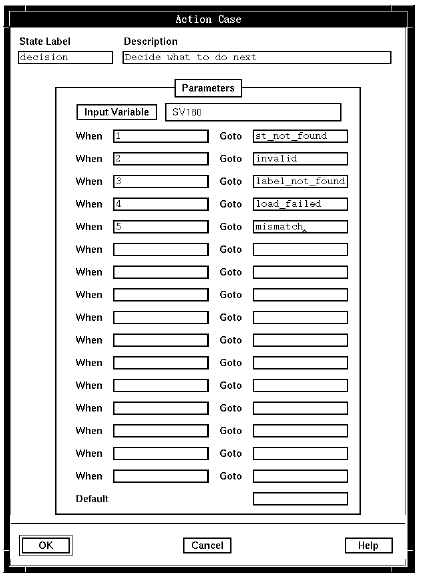Purpose
Use the Case action to choose the next action to be performed according to the text string value of a specified variable. This avoids the use of multiple EvaluateData actions.

Description
If needed, type an identifying label in the State Label field, and a description. Click Input Variable to select a variable or Add a new one. In the When fields type the text strings to be compared with the input variable. If null or blank is a possible value, type two double quotes (""). Type the state label of the action in the corresponding Goto field.
If you want to use wildcards in your case statement, set system variable SV238, (System : Case : Pattern matching allowed) to 1.
Parameters
- Input Variable. The variable that contains the value with which the text strings are to be compared.
- When. A text string with which the Input Variable is to be compared.
- Goto. The label of the action to be taken if the Input Variable contains the corresponding text string.
- Default. The label of the action to be taken if the Input Variable contains a text string not specified in any of the When parameters.
Possible results
There are no results as such. If the Input Variable contains one of the text strings specified in the When parameters, the next action is the one identified by the corresponding Goto. If the Input Variable contains a text string not specified in any of the When parameters, the next action is the one identified by the Default parameter or, if no Default is specified, the next action in the state table.
ASCII syntax
When using an ASCII editor, you would normally use the CASE statement. The CaseAction statement is included for consistency with the window interface. If you prefer to use the CaseAction statement, code it with these parameters in the following order:
- Input variable
- Up to sixteen pairs of placeholders and values. The placeholders are "COMPARE_1" through "COMPARE_16". The values are the values against which the input variable is to be compared. The edges that correspond to the placeholders specify the "goto" labels.
For example:
label: "Check Edges" CaseAction(in1_n, "COMPARE_1", 1, "COMPARE_2", 2, "COMPARE_3", 3) edge EDGE_CASE_DEFAULT: default_edge edge EDGE_CASE_COMPARE_1: comp_1 edge EDGE_CASE_COMPARE_2: comp_2 edge EDGE_CASE_COMPARE_3: comp_3 edge EDGE_CASE_COMPARE_4: comp_4 edge EDGE_CASE_COMPARE_5: comp_5 edge EDGE_CASE_COMPARE_6: comp_6 edge EDGE_CASE_COMPARE_7: comp_7 edge EDGE_CASE_COMPARE_8: comp_8 edge EDGE_CASE_COMPARE_9: comp_9 edge EDGE_CASE_COMPARE_10: comp_10 edge EDGE_CASE_COMPARE_11: comp_11 edge EDGE_CASE_COMPARE_12: comp_12 edge EDGE_CASE_COMPARE_13: comp_13 edge EDGE_CASE_COMPARE_14: comp_14 edge EDGE_CASE_COMPARE_15: comp_15 edge EDGE_CASE_COMPARE_16: comp_16 ;
The parameters and edges are described above under "Parameters" and "Possible results". For more information, see Testing a state table using the debugger.